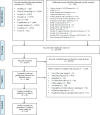Interventions to reduce risk for sexually transmitted infections in adolescents: A meta-analysis of trials, 2008-2016
- PMID: 29953546
- PMCID: PMC6023153
- DOI: 10.1371/journal.pone.0199421
Interventions to reduce risk for sexually transmitted infections in adolescents: A meta-analysis of trials, 2008-2016
Abstract
Background: Numerous studies have evaluated the efficacy of interventions to reduce risk for sexually transmitted infections in adolescents in recent years, but their global effects remain unknown since 2008, the last date of a comprehensive review of prior studies.
Aims: This study aims at evaluating the efficacy of interventions to promote sexual health, reduce STIs and unplanned pregnancies targeted to adolescents available after 2008; and analyzing the moderators of their global efficacy.
Methods: We searched electronic databases and manual searches of some journals focused on STIs in May 2016. The studies evaluated the efficacy of interventions to reduce sexual risk in adolescents (age range: 11-19) anywhere in the world. Effect size of the relevant outcomes for sexual risk was calculated for every study. Analyses incorporated random-effect assumptions for each outcome. The homogeneity in the results was examined with the I2 statistic and its associated 95% confident interval.
Results: Data from 63 studies (59,795 participants) were analyzed for behavioral and non-behavioral outcomes. In the short term, interventions had a positive impact in sexual health-related knowledge (Hedges'g = 1.01), attitudes (g = 0.29), self-efficacy toward condom use (g = 0.22), intention to refuse sex (g = 0.56), condom use intention (g = 0.46), and condom use (g = 0.38). In the medium term, positive effects observed at the short-term were maintained, although effect size significantly decreased in all variables. In the long term, interventions improved condom use (g = 0.47). Moderators of the efficacy are discussed.
Conclusions: Sexual health promotion interventions are effective to promote sexual health through increasing condom use. Effects on non-behavioral variables tend to decrease over time, while condom use increased in the long-term. Interventions should focus on the long-term efficacy, especially in behavioral and biological measures.
Conflict of interest statement
The authors have declared that no competing interests exist.
Figures








References
-
- UNICEF. Strengthening the Adolescent Component of National HIV Programmes through Country Assessments Guidance Document. Adolescent Assessment and Decision-Makers’ (AADM) Tool [cited 2016 Jun 15]. Available from: http://data.unicef.org/wp-content/uploads/2016/04/Guidance-on-Country-As...
-
- Idele P, Gillespie A, Porth T, Suzuki C, Mahy M, Kasedde S, et al. Epidemiology of HIV and AIDS among adolescents: current status, inequities, and data gaps. J Acquir Immune Defic Syndr. 2014;66 Suppl 2:S144–53. doi: 10.1097/QAI.0000000000000176 - DOI - PubMed
-
- World Health Organization (WHO). Sexually Transmitted Infections among adolescents. The need for adequate health services [cited 2016 Jun 15]. Available from: http://www.who.int/maternal_child_adolescent/documents/9241562889/en/.
-
- UNICEF. Opportunities in times of crisis: Preventing HIV from early adolescence to early adulthood. 2011 [cited 2016 Jul 20]. Available from: http://www.unicef.org/publications/files/Opportunity_in_Crisis-Report_EN.... Accessed August 30, 2016.
-
- Leppälahti S, Gissler M, Mentula M, Heikinheimo O. Is teenage pregnancy an obstetric risk in a welfare society? A population-based study in Finland, from 2006 to 2011. BMJ Open. 2013;3:e003225 doi: 10.1136/bmjopen-2013-003225 - DOI - PMC - PubMed
Publication types
MeSH terms
Grants and funding
LinkOut - more resources
Full Text Sources
Other Literature Sources
Medical

